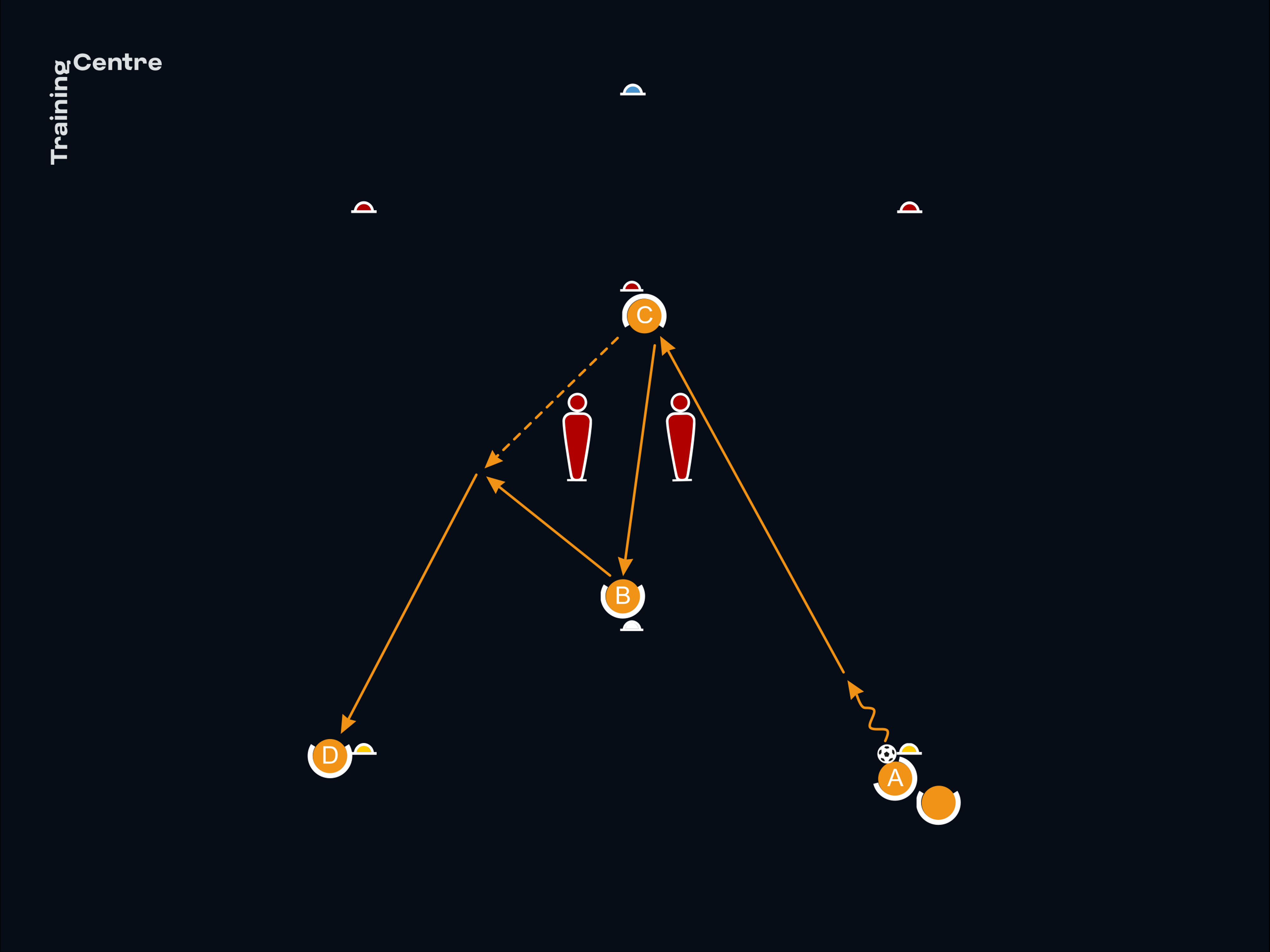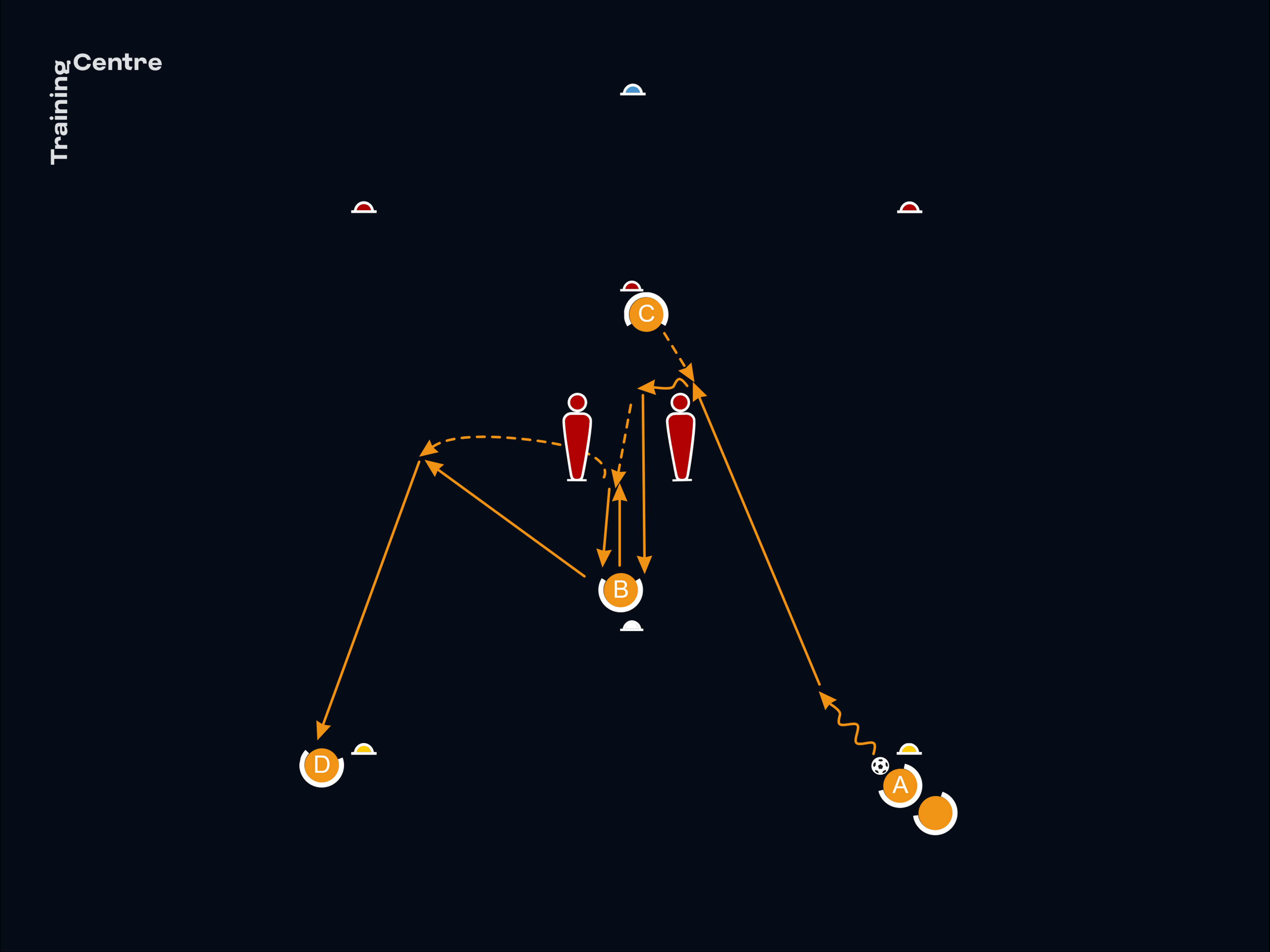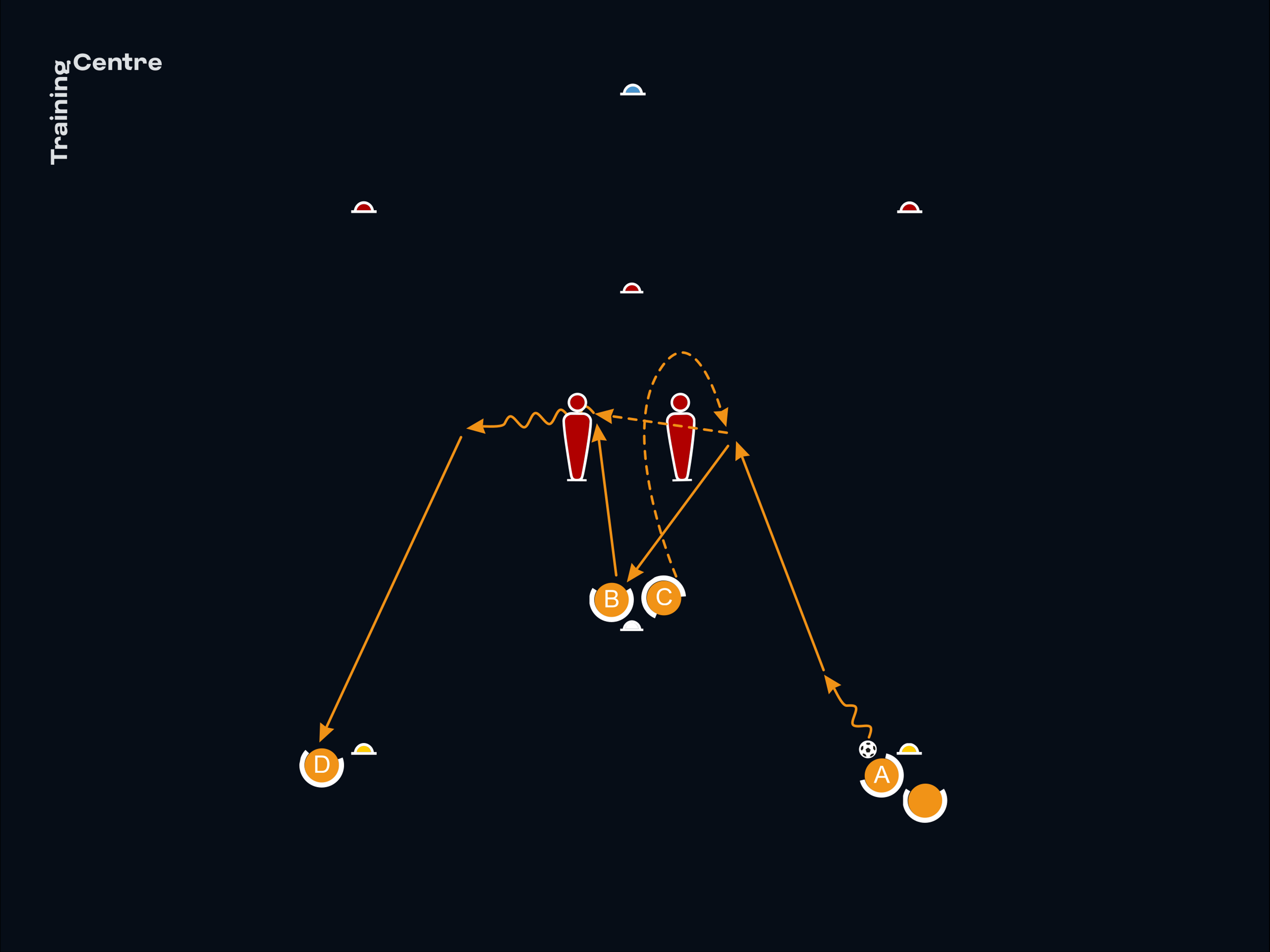This circuit, as is the case with all of the others in this series, can be set up in different sizes (small, medium and large) so as to allow for various ranges of passing and movement and different combinations. The circuit that features in this article is medium-sized.
Set-up for all drills
.jpg)
Organisation
- Lay out a 15x15m square marked with flat cones (a).
- Create a 2m-wide mannequin gate, whose midpoint is 10m from the flat cones at each corner (b).
- Place a flat orange cone 3-4m from the middle of the gate (c)
- Place a flat white cone 5m from the middle of the gate, on the opposite side to the orange cone (d).
- Place a blue cone 9-10m from the middle of the gate, on the same side as the orange cone (use 10m for a slightly higher intensity) (e).
- In the event that no mannequins are available, cones/discs or poles may be used instead.
Drill duration
- 5 players: 2-3 minutes.
- 6-7 players: 3-4 minutes.
Approximate workload intensity
- 5 players: medium to higher intensity (optimum player number).
- 6 players: lower to medium intensity.
- 7 players: lower intensity.
Coaching points that apply to all drills
- Allow players 30 seconds to find their tempo and familiarise themselves with the scenario, before gradually raising the intensity demands.
- Devote a period of time (minimum of 1 minute) during each drill to focus on high tempo, correct technique, technical balance and reinforcement of awareness habits.
- Encourage players to move quickly between positions.
Drill 1: One-two play and coordinated movement in tight spaces

Sequence
- A serves the ball to C, who is waiting near the red cone.
- C moves towards the mannequin gate and plays a first-time one-two with B.
- B is waiting at the white cone and plays a first-time lay-off beyond the gate.
- C moves quickly into the space beyond the gate to latch onto B's lay-off and finishes the sequence with a diagonal pass out to D at the starting position on the opposite side.
- D then starts the next sequence in the opposite direction by passing to the next player in position C.
Player rotation
- A moves to B.
- B moves to C.
- C moves to D.
Coaching points
- Encourage "server" players (A and D) to be switched on and ready to play the pass quickly.
- Players should play with their heads up and scan the area they are receiving the pass from and where they intend to pass to.
- This drill is technically balanced, requiring an equal use of left and right foot.
Focus on C's technical balance, cohesion & habits
- When receiving the initial diagonal pass from A from the left (or, for subsequent sequences, from D from the right), C can pass to B with whichever foot is most suitable for a quick one-two.
- The diagonal pass out to D on the opposite side should ideally be right-footed and be played into D’s path. The opposite (i.e. a left-footed final pass to A) applies when the drill goes from right to left.
Drill 1
Drill 2: Quick feet and coordination in tight spaces

Sequence
- A serves the ball to C outside of the mannequin gate.
- C appears from behind the gate and quickly moves to the outside, receives A's pass and move the ball laterally to in between the gate with one touch.
- C's second touch is a pass to B.
- B then plays a quick follow-up one-two through the gate with C, making for a total of three straight passes through the gate.
- Following the one-two, B plays a short diagonal pass into the movement path of C beyond the gate.
- C finishes the sequence by passing diagonally to D at the starting position on the opposite side.
- D then starts the next sequence in the opposite direction by passing to the next player in position C.
Player rotation
- A moves to B.
- B moves to C.
- C moves to D.
Coaching points
- Encourage "server" players (A and D) to be switched on and ready to play the pass quickly.
- Players should play with their heads up and scan the area they are receiving the pass from and where they intend to pass to.
- This drill is technically balanced, requiring an equal use of left and right foot.
Focus on C's technical balance, cohesion & habits
- When receiving the diagonal pass from A from the left, C should control/shift the ball with the left foot and then change feet to pass right-footed to B with the second touch.
- Then C can use whichever foot is most suitable for the one-two between the gate with B.
- The final diagonal pass out to D on the opposite side should ideally be right-footed and be played into D's path.
- The opposite applies when the drill goes from right to left.
- Ideal left-to-right sequence: left foot, right foot, either foot, right foot.
- Ideal right-to-left sequence: right foot, left foot, either foot, left foot.
Drill 2
Drill 3: Accelerating into space and quick feet in tight spaces

Sequence
- A serves the ball to C to the outside and in line with the mannequin gate.
- C starts with a run through the gate to the red cone beyond the middle, followed by a quick direction change to receive A's pass outside the gate.
- C then plays a short diagonal pass to B and moves towards the middle of the gate to receive a return pass from B.
- C moves the ball laterally past the gate with the first touch and finishes the sequence by playing a diagonal pass with the second touch to D at the starting position on the opposite side.
- D then starts the next sequence in the opposite direction by passing to the next player in position C.
Player rotation
- A moves to B.
- B moves to C.
- C moves to D.
Coaching points
- Encourage "server" players (A and D) to be switched on and ready to play the pass quickly.
- Players should play with their heads up and scan the area they are receiving the pass from and where they intend to pass to.
- This drill is technically balanced, requiring an equal use of left and right foot.
Focus on C's technical balance, cohesion & habits
- When receiving the initial diagonal pass from A from the left, C should use whichever foot is most suitable to speed the sequence up for the short diagonal pass to B.
- Then, if the return pass from B enables, C should use the left foot to move the ball laterally across the mannequins with the first touch and play a right-footed second-touch pass to the opposite side, into D's path.
- The opposite applies when the drill goes from right to left.
- Ideal left-to-right sequence: short diagonal pass with either foot, move the ball from the left to the right foot, right-footed final diagonal pass.
- Ideal right-to-left sequence: short diagonal pass with either foot, move the ball from the right to the left foot, left-footed final diagonal pass.
Drill 3
Drill 4: Quick feet, turn and play forward

Sequence
- C opens the sequence from the red cone by accelerating through the mannequin gate, before changing direction and facing A on the half-turn.
- A serves a diagonal pass to C across and beyond the gate.
- C controls the ball with the first touch, plays a straight pass to B with the second and shows quick feet to move to the opposite side of the gate.
- B plays a return pass to C.
- C, receiving that pass on the half-turn, finishes the sequence by playing a diagonal pass to D in the opposite corner.
- D then starts the next sequence in the opposite direction by passing to the next player in position C.
Player rotation
- A moves to B.
- B moves to C.
- C moves to D.
Coaching points
- Encourage "server" players (A and D) to be switched on and ready to play the pass quickly.
- Players should play with their heads up and scan the area they are receiving the pass from and where they intend to pass to.
- Players must rotate positions very quickly to keep the drill going.
- This drill is technically balanced, requiring an equal use of left and right foot.
Focus on C's technical balance, cohesion & habits
- Encourage C to scan towards D before receiving the pass from A.
- Also encourage C to scan towards D before receiving the return pass from B.
- When receiving the initial diagonal pass from A from the right, C should ideally let the ball run across (or move it across) to the left foot and play a left-footed straight pass back to B. Then, after receiving the return pass from B, C should ideally again let the ball run across to the left foot and play a left-footed diagonal pass to D.
- The opposite applies when the drill goes from left to right.
- Ideal sequence starting with a diagonal pass from A from the right: left-footed straight pass to B, left-footed diagonal pass to D.
- Ideal sequence starting with a diagonal pass from D from the left: right-footed straight pass to B, right-footed diagonal pass to A.
Drill 4





















